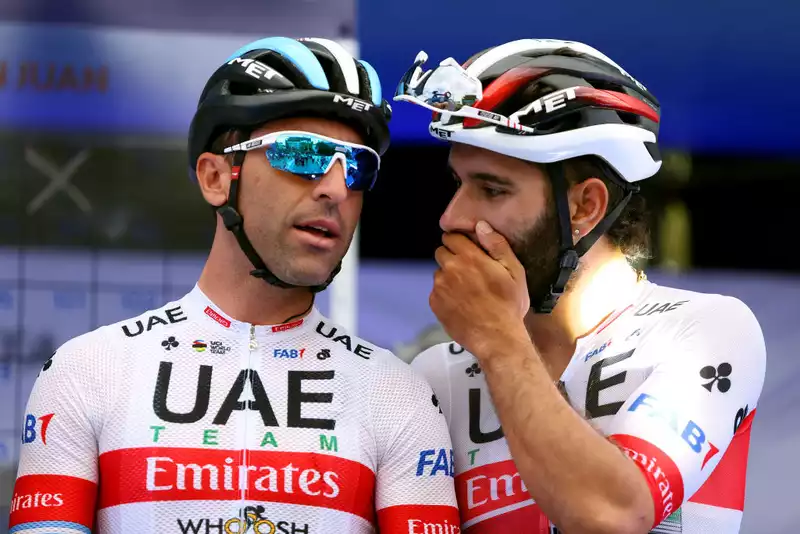At a recent team presentation for the Detunink Quickstep, coach Patrick Lefebvre regretted the departure of Max Richeze, one of the best lead-out men in the pro peloton. During his four years with the team, Richeze led a number of sprinters to victory, including Tom Boonen, Alvaro Hodeg, and Elia Viviani, but opted to move to UAE Team Emirates before the 2020 campaign.
While Lefebvre's reluctance to offer a contract longer than 12 months to a player approaching his 37th birthday was undoubtedly a factor in Richetts' decision, so was Fernando Gaviria's insistence.
When Quick Step acquired Gaviria in late 2015, they quickly added Richeze as his lead out man. The South American duo had a fruitful partnership until Gaviria terminated his contract with Quick Step last year and moved to UAE Team Emirates. Gaviria's first season with his new team was plagued by a knee injury, but also by the absence of his closest confidant in the peloton.
"I had some of the best years of my career so far at Quick Step," he said. 'It was my friendship with Fernando that made this decision possible. I also had a good relationship with other people in the team, like Matosin [coach Jocsen Fernandez]. That helped me to make the decision to move. In the end, I had a great four years there, but I chose to follow my heart and join Fernando.
Every day at the Vuelta a San Juan, Richeze is always on track with Gaviria in the peloton. Outside of racing, the two are also regular training partners: Gaviria and Richeze rent an apartment on the same block in Monaco.
"You don't need to be friends to work," Gaviria says. But if you have that kind of relationship off the bike, you can always dedicate a little more to your teammates, or in this case my friends."
The seamless partnership between sprinter and lead-out man is not based solely on friendship, however. Riches argues that the two share a track background, which has helped them understand each other almost intuitively amidst the frenzied running frenzy. The two also have a very similar intuition about positioning themselves within the peloton, he says.
"We have the same racing mentality and we see things the same way, so we don't talk much in the finale. He can just call me 'Max' and I understand what he wants. If he calls my name, I understand that he has lost a wheel or that we are not in the right position. At the finale of the race, we each understand."
"From the first race we understood each other. Fernando has a special personality and sometimes it takes time to gain his trust, but as for me, from the first race we raced together, the Tour de San Luis, he trusted me blindly."
Hailing from Bellavista, near Buenos Aires, Richeze comes from a cycling family and is a product of Argentina's long tradition of track competitions. Track cycling is the most popular sport in and around the capital city of Buenos Aires. Only in the western province of San Juan, Richeze explains, is there a full calendar of road racing.
Richese's love for road racing led him to Italy as an amateur and he turned pro in Panaria in 2006. His career was interrupted by a two-year doping ban in 2008 due to a positive test for stanozolol (a steroid), but he returned to racing with Team Nippo before stepping up to the World Tour in 2013 with Lampre-Merida.
At that point, Richeze was still nominally a sprinter, with 17 wins, but during his tenure in Lampre he gradually became repurposed as a lead-out man.
"Sprinters are stubborn, but they made me understand that I had to change," Richeze laughed. [25] "When I was with Matsin in Lampre, he started talking to me about it. As a sprinter, sure I won three or four races a year, but a sprinter on a big team needs to win 10 or more. Matosin said that if I wanted to extend my career, I should consider becoming a lead-out man."
At least initially, the change in rank was not easy to digest. Sprinters are forced to think only of themselves and compete to the finish line. Lead-out men are required to develop an altruistic streak and adapt to racing only to an invisible goal with about 200 meters to go.
"I had to change my mentality, and it wasn't easy at first," Riches admitted.
Since changing his vocation, he has tasted victory--he is the reigning Argentine and Pan American road race champion--but not as often as during his sprinter days. But not as often as in his sprinter days. The feeling is different from being at the top of the podium, but it is rewarding in its own way.
"It's not exactly the same, but the emotion is very strong. There are goals that I could never have reached if I had stayed a sprinter, like when Fernando won the yellow jersey at the 2018 Tour de France."
"It was a very strong emotion to lead the sprint for Fernando in my first Tour de France and to watch him take the yellow jersey. At that finish line, I felt like I had won too, because I was part of the victory."
[11When Gaviria won the first stage of the Vuelta a San Juan in Pocito on Monday, Richeze was the victim of a crash with 13 km to go and missed the finale.
"You win more with him than without him," Gaviria said, and Wednesday evening's fourth stage to San Agustin del Valle Fertil seemed to prove his point. After Richeze crossed the finish line with 200 meters to go, Gaviria took his second win of the week.
.

Comments